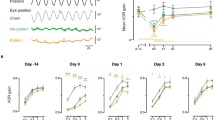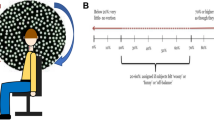Summary
Squirrel monkeys were trained to cancel their vestibulo-ocular reflex (VOR) by fixating a visual target that was head stationary during passive vestibular stimulation. The monkeys were seated on a vestibular turntable, and their heads were restrained. A small visual target (0.2°) was projected from the vestibular turntable onto a tangent screen. The monkeys' ability to suppress their VOR by fixating a head stationary target while the turntable was moving was compared to their ability to pursue the target when it was moved in the same manner.
Squirrel monkeys were better able to suppress their VOR when the turntable was moved at high velocities than they were able to pursue targets that were moving at high velocities. The gaze velocity gain during VOR cancellation began to decrease when the head velocity was above 80°/s, and was greater than 0.6 when the head velocity was above 150°/s. However, gaze velocity gain during smooth pursuit decreased significantly when the target velocity was greater than 60°/s, and was less than 0.4 when the target velocity was 150°/s or more.
The latency of VOR suppression was significantly shorter than the latency of smooth pursuit while the monkey was cancelling its VOR. When an unpredictable step change in head acceleration was generated while the monkey was cancelling its VOR, the VOR evoked by the head acceleration step began to be suppressed shortly after the initiation of the step (≈ 30 ms). On the other hand, the latency of the smooth pursuit eye movement elicited when the visual target was accelerated in the same manner during VOR cancellation was ≈ 100 ms. The comparison between these two results suggests that the monkeys did not use visual information related to target motion to suppress their VOR at an early latency.
The monkeys' ability to suppress the VOR evoked by an unexpected change in head acceleration depended on the size of the head acceleration step. The VOR evoked by unexpected step changes in head acceleration was progressively less suppressed at an early latency as the size of the acceleration step increased, and was not suppressed at an early latency when the step change in head acceleration was greater than 500°/s2.
During smooth pursuit eye movements, unexpected step changes in head acceleration evoked a VOR that was suppressed at an early latency (≈ 50 ms) if the head movement was in the same direction as the ongoing smooth pursuit eye movement. The amount of early VOR suppression increased as the pursuit eye velocity increased.
We conclude that squirrel monkeys utilize a fast, non-visual mechanism for cancelling their VOR while they are fixating a visual target and their head is moving. This non-visual mechanism appears to be turned on when the head is moving and the monkey is fixating a head stationary target. The mechanism probably utilizes a voluntarily gated vestibular signal to cancel the signals in VOR pathways at the level of the extraocular motorneurons. Although the VOR cancellation mechanism is not capable of completely suppressing the VOR evoked by large unexpected changes in head acceleration, we suggest that it is capable of suppressing the VOR generated by most voluntary head movements during combined eye and head gaze pursuit and that the function of this gated VOR cancellation system is to extend the range and accuracy of eye-head tracking movements.
Similar content being viewed by others
References
Baloh RW, Lyerly K, Yee RD, Honrubia V (1984) Voluntary control of the human vestibulo-ocular reflex. Acta Otolaryngol (Stockh) 97:1–6
Barnes GR, Eason RD (1988) Effects of visual and non-visual mechanisms on the vestibulo-ocular reflex during pseudo-random head movements in man. J Physiol (Lond) 395:383–400
Barnes GR, Lawson JF, (1989) Head free pursuit in the human of a visual target moving in a pseudo-random manner. J Physiol 410:137–155
Barr CC, Schultheis LW, Robinson DA (1976) Voluntary, nonvisual control of the human vestibulo-ocular reflex. Acta Otolaryngol (Stockh) 81:365–75
Bizzi E, Kalil RE, Tagliasco V (1971) Eye-head coordination in monkeys: evidence for centrally patterned organization. Science 173:452–454
Bizzi E, Kalil RE, Morasso P (1972) Two modes of active eye-head coordination in monkeys. Brain Res 40:45–48
Buizza A, Schmid R (1986) Velocity characteristics of smooth pursuit eye movements to different patterns of target motion. Exp Brain Res 2:395–401
Carl JR, Gellman RS (1987) Human smooth pursuit: stimulus-dependent responses. J Neurophysiol 57:1446–63
Chambers BR, Gresty MA (1983) the relationship between disordered pursuit and vestibulo-ocular reflex suppression. J Neurol Neurosurg Psychiat 46:61–66
Dell'Osso LF, Abel LA, Daroff RB, Troost BT (1981) Absence of VOR suppression in the presence of intact pursuit. Invest Opthal Vis Sci Suppl 20:57
Fuchs AF (1967) Saccadic and smooth pursuit eye movements in the monkey. J Physiol (Lond) 191:609–631
Fuller JH (1988) Chronic recording of neck sensory input to vestibular neurons. In: Peterson B, Richmond FJ (eds) Control of head movements, Oxford Press, New York, pp 120–129
Fuller JH, Maldonado H, Schlag J (1983) Vestibular-oculomotor interaction in cat eye-head movements. Brain Res 271:241–50
Gauthier GM, Pirion J, Roll J, Marchetti E, Martin B (1984) High frequency vestibulo-ocular reflex activation through forced head rotation in man. Aviat Space Environ Med 55:1–7
Grossman GE, Leigh RJ, Abel LA, Lanska DJ, Thurston SE (1988) Frequency and velocity of rotational head perturbations during locomotion. Exp Brain Res 70:470–476
Grossman GE, Leigh RJ, Brace EN, Huebner WP, Lanska DJ (1989) Performance of human vestibulo-ocular reflex during locomotion. J Neurophysiol 62:264–271
Guitton D, Volle M (1987) Gaze control in humans: eye-head coordination during orienting movements to targets within and beyond the oculomotor range. J Neurophysiol 58:427–459
King WM, Lisberger SG, Fuchs AF (1976) Responses of fibers in the medial longitudinal fasciculus (MLF) in alert monkeys during horizontal and vertical conjugate eye movements evoked by vestibular or visual stimulation. J Neurophysiol 39:1135–1149
Koenig E, Dichgans J, Dengler W (1986) Pursuit opposite to the vestibulo-ocular reflex (VOR) during sinusoidal stimulation in humans. Acta Otolaryngol (Stockh) 103:24–31
Lanman J, Bizzi E, Allum J (1978) The coordination of eye and head movement during smooth pursuit. Brain Res 153:39–53
Laurutis VP, Robinson DA (1986) The vestibulo-ocular reflex during human saccadic eye movements. J Physiol (Lond) 373:209–233
Leigh RJ, Mass EF, Grossman GE, Robinson DA (1989) Visual cancellation of the torsional vestibulo-ocular reflex in humans. Exp Brain Res 75:221–226
Lisberger SG (1990) Visual tracking in monkeys: evidence for short latency suppression of the vestibulo-ocular reflex. J Neurophysiol 63:676–688
Lisberger SG, Evinger C, Johanson GW, Fuchs AF (1981) Relationship between eye acceleration and retinal image velocity during foveal smooth pursuit in man and monkey. J Neurophysiol 46:229–249
Matsuo V, Peterson BW (1988) Human subjects suppress the vestibulo-ocular reflex during visual pursuit. Soc Neurosci Abstr 14:959
McKinley PA, Peterson BW (1985) Voluntary modulation of the vestibulo-ocular reflex in humans and its relation to smooth pursuit. Exp Brain Res 60:454–464
Melvill-Jones G, Berthoz A, Segal B (1984) Adaptive modification of the vestibulo-ocular reflex by mental effort in darkness. Exp Brain Res 56:149–153
Miles FA, Kawano K, Optican LM (1986) Short-latency ocular following responses of monkey. I. Dependence on temporospatial properties of visual input. J Neurophysiol 56:1321–1354
Pelisson D, Prablanc C, Urquizar C (1988) Vestibulo-ocular reflex inhibition and gaze saccade control characteristics during eye-head orientation in humans. J Neurophysiol 59:997–1013
Pola J, Robinson DA (1978) Oculomotor signals in the medial longitudinal fasciculus of the monkey. J Neurophysiol 41:245–259
Pulaski PD, Zee DS, Robinson DA (1981) The behavior of the vestibulo-ocular reflex at high velocities of head rotation. Brain Res 222:159–165
Rashbass C (1961) The relationship between saccadic and smooth pursuit tracking eye movements. J Physiol (Lond) 159:326–338
Robinson DA (1982) A model of cancellation of the vestibulo-ocular reflex. In: Lennerstrand G, Zee DS, Keller EL (eds) Functional basis of ocular motility disorders. Pergamon Press, Oxford, pp 5–13
Tomlinson RD, Bahra PS (1986) Combined eye-head gaze shifts in the primate. II. Interactions between saccades and the vestibulo-ocular reflex. J Neurophysiology 56:1158–1570
Tomlinson RD, Robinson DA (1984) Signals in vestibular nucleus mediating vertical eye movements in the monkey. J Neurophysiol 51:1121–1136
Author information
Authors and Affiliations
Rights and permissions
About this article
Cite this article
Cullen, K.E., Belton, T. & McCrea, R.A. A non-visual mechanism for voluntary cancellation of the vestibulo-ocular reflex. Exp Brain Res 83, 237–252 (1991). https://doi.org/10.1007/BF00231150
Received:
Accepted:
Issue Date:
DOI: https://doi.org/10.1007/BF00231150




